2008 Crop Trip Report: Brazil Expected to Produce Three Record 2007/08 Crops
Brazil is forecast in 2007/08 to produce three record crops for corn, cotton and soybeans due to a combination of increased planted area and favorable weather. Brazil’s 2007/08 soybean crop is forecast at a record 61.0 million tons on 21.5 million hectares, with a record yield of 2.86 tons/ha. The 2007/08 corn crop is forecast at record 53 million tons on 14.5 million hectares, with a record yield of 3.65 tons/ha. The 2007/08 cotton crop is forecast at 7.1 million bales on 1.15 million hectares, with a near-record yield of 1363 kg/ha.
February 2008 Crop Assessment Tour
FAS-Washington and Brasilia personnel performed a crop assessment tour from February 15-March 5, 2008 in southern and center-west Brazil, as indicated in Figure 1, and the survey team transected the main grain and soybean belts in Mato Grosso and Parana states. Many producers were beginning to plant the second or safrinha crop in both Mato Grosso and Parana states where double-cropping is possible.
Crop stage for the summer crops ranged from grain-filling (or pod-filling) to harvest, and summer crop production prospects ranged from good to excellent. In general, onset of rains for planting during September and October were delayed by 2-3 weeks, but rainfall after planting was well-distributed and near-average during the main growing season. Several regions also experienced at least one extended period of dryness during the growing season, such as soybeans in Rio Grande do Sol and cotton in western Bahia.
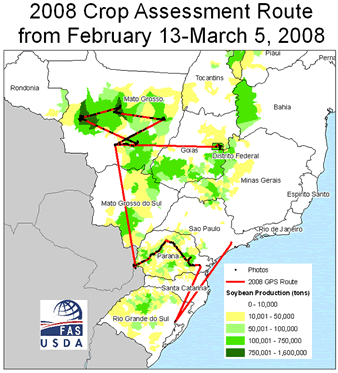
Figure 1. 2008 Crop Assessment Route in Brazil
Producers, traders, cooperatieve managers, agricultural extension officiers and government officials were interviewed along the survey route. Summary field observations, interviews, and comments by these people are listed below for the three record 2007/08 crops observed in the field.
2007/08 Corn Production Prospects
Reported yields from the summer corn harvest were above-average by all producers interviewed due to optimal weather since planting in October. High corn prices in January and February encouraged producers to plant 7 percent more safrinha (winter) corn area than last year. However, wet weather during February delayed planting the winter safrinha crop and late planted safirnha crops have higher risks of crop damage from drought and frost at the end of the growing season. Producers and agricultural extension agents mentioned the last date for planting safrinha crops ranges from mid-February to mid-March (depending on location), and planting safrinha corn after March 1st is considered too risky due to frost damage in Parana and droughts in Mato Grosso during late April and May.
In general, the summer corn crop accounted for nearly 70 percent of the total national output and the winter safrinha crop accounted for the remaining 30 percent. Winter corn yields also tend to be lower than summer corn yields due to shorter-season varieties having lower yield potential, and winter corn yields having higher yield variability due to greater weather risks at the end of the growing season (refer to Figure 2).
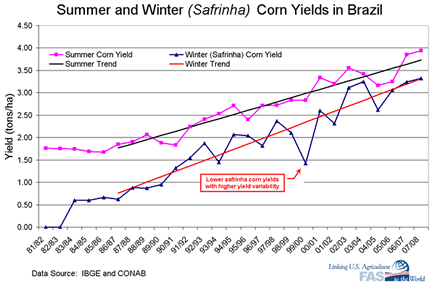
Figure 2. Summer and Winter Corn Yields in Brazil
2007/08 Cotton Production Prospects
Mid-season crop conditions for summer cotton in Mato Grosso ranged from good to excellent due to favorable weather and excellent growing conditions after planting. Mato Grosso producers also were planting safrinha cotton when we visited at the end of February and cotton growers from Sapezal municipality expected total safrinha cotton area to be the same as last year for their municipality and for the entire state of Mato Grosso as well.
Mato Grosso is the largest producing cotton state and accounts for approximately 52 percent of the country’s total output, while Bahia and Goias are the second and third largest producing states and account for 31 and 6 percent of the crop, respectively. National cotton yields continue to increase rapidly as production shifts to the higher yielding states in the north and more GMO cotton is being planted nationwide. Currently, approximately 50 percent of the cotton crop is estimated to be planted with GMO cotton seeds.
2007/08 Soybean Production Prospects
January’s soybean harvest was late in both Parana and Mato Grosso due to the crop being planted 2-3 weeks late during September or October, and from harvest delays caused by heavy rains during January and early February. However, even with these delays, the harvest pace witnessed at the beginning of March was near-average due to sunny weather during the end of February and the harvest pace in mid-April is reported to be near-average, or 71 percent complete. Reported soybean harvest yields were above last year's yields for most producers interviewed in Mato Grosso and Parana, while potential soybean yields in Rio Grande do Sol were reported to be lower than last year due to dryness during the end of February.
Several producers from both Parana and Mato Grosso stated several times that they were planting more early-season soy varieties which tend to be less susceptible to rust and these early soy varieties make it easier to plant a safrinha crop such as corn or cotton, where double-cropping is feasible. They also stated the trend next season will be to plant more early-season soy varieties due to the recent release of 10-11 new early-season soy varieties. Several prodcuers also mentioned that they prefer to plant a mixture of early-, mid-, and late-season varieties to spread out harvest dates and help keep all harvesting machines busy during the entire harevst season.
Reported soybean rust cases were also less than last year in Mato Grosso due to delayed planting, relatively drier weather, more use of early-season varieties, more chemical applications to control rust, and newly enacted state bans that prohibit the growing of soybeans for 90-days from June 15th through September 15th. The soybean “Free Host Period” (FHP) state laws help to prevent rust spores from spreading from mono-cropping, and encourage producers to increase crop rotations whereby soybean is not planted as a second crop and soy harvest dates do not extend into late-June or within the FHP.
2008/09 Crop Area Prospects
General comments by producers, traders, and government agricultural officials regarding the 2008/09 crop area prospects are listed below and note that these comments do not reflect FAS opinions but paraphrase ideas and comments that were often repeated independently by several different producers and analysts. In general, industry analysts agreed on trend directions for corn, cotton, and soybeans, but opinions diverged concerning the rate of area growth for the next planting season due to daily changes in commodity prices, cost of production increases (for fertilizer, seed, chemicals, fuel, etc.) cost of transportation increases, depreciation of the US dollar, availability of credit, rescheduling current debts or debt forgiveness, and actual crop area plantings for the U.S. corn and soybean crops in 2008.
2008/09 Corn Area Prospects
Corn area in Brazil is expected to increase in 2008/09 due to high corn prices, but producers do not have an excess of capital for large area expansion because potential profits this year were low in Mato Grosso from early soybean commitments and rising fertilizer and transportation costs. However, safrinha corn area for 2008/09 should increase by another 5-10 percent and planting more early-maturing soybean varieties during the main season should allow producers to plant more corn as a second season crop.
Brazil’s domestic consumption of corn is also increasing annually because feedlots for cattle, swine, and poultry are increasing, especially in Mato Grosso where it’s cheaper to export meat from feedlots rather than to export grain and soybeans.
Brazil also needs to increase national corn production by increasing corn yields because a national yield of 4 tons/hectare is low (refer to Figure 3). In addition, with the recent introduction of Bt corn in Brazil, national corn yields should increase because Bt corn will be planted to control corn stalk borer and another stalk borer that feeds on both corn and sugarcane.
Producers should stop mono-cropping soybean and rotate soybean with different crops such as corn, rice and cotton. Nematodes are another problem and crop rotations will help to control nematodes especially with rice rotations. It’s also better to grow corn as a second season crop rather than soybeans as second crop so that a late maturing soy harvests do not possibly extend into the 90-day Free Host Period (FHP).
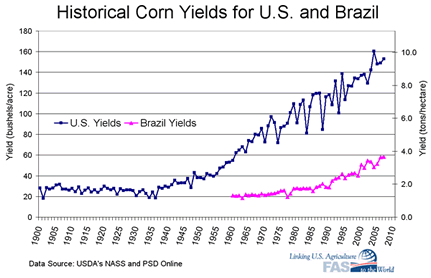
Figure 3. Brazil Corn Yields Compared to the U.S.
2008/09 Cotton Area Prospects
Total cotton area for 2008/09 should remain the same or be slightly less because the government provides cotton producers with a minimum price and cotton producers will try to maintain cotton area as they have already invested in cotton gins and harvesters. Cotton producers also like rotating cotton with soy because 1-2 seasons of soybeans should provide good yields behind one cotton crop that was well-fertilized.
On the other hand, cotton area in Mato Grosso could decrease slightly in the next two years because Mato Grosso producers will make fewer forward commitments and cotton is currently the third crop of choice, behind soy and corn, especially with current high prices for soy and corn. Also, safrinha corn area in 2008/09 is expected to take from safrinha cotton area in Mato Grosso because corn prices are high and next year cotton commitments will be less than this year. In contrast, cotton area in western Bahia should continue to increase because good quality cotton easily grows there from favorable weather with plenty of sunshine.
Total national 2007/08 cotton area did not go down this year, when both corn and soy prices were high, because cotton producers were already committed. However, cotton commitments will probably gradually decrease from 2008 to 2010 if prices for corn and soy remain at current high levels.
Current hindsight reveals that forward commitments for soybean and cotton was a bad idea, but producers thought it was a good idea at the time because they had no idea how high commodity prices would climb or how low the US dollar would drop.
National cotton yields also should increase as production continues to shift to higher yielding states in the north and more GMO cotton is being planted. Currently, approximately 50 percent of the crop is GMO cotton.
2008/09 Soybean Area Prospects
Total soybean area should increase from 3-10 percent, with most analysts favoring only a modest increase in soybean area of 3-5 percent from last year. Soybean area should remain constant in Parana, and most soybean area expansion will occur in the center-west states. In addition, double-cropping will increase where it is possible because 10-11 new early-season soybean varieties will be available next season and producers will plant more of these early-season soy varieties which inturn will increase their potential to double-crop.
Soybean area also has the potential to expand in the center-west states, but producers in the center-west will be more reluctant to increase soy area at 10 percent rates, as they did several years ago, due to past debts which have been increasing over the years due to high interest rates. In contrast, producers in Parana tend to have less debt, more cooperatives, and less potential area for expansion in comparison to Mato Grosso producers who have more pastures that could be converted into cropland but also have more debt.
Several years ago, soybean area in Brazil expanded greater than ten percent for several consecutive years and this large area expansion was mostly financed by multi-national loans with high interest rates. It’s also estimated that at least a third to two-thirds of the Mato Grosso producers are still in debt from this rapid area expansion. Of course, traders and government officials would like soybean area to increase 10 percent or more next year in order for Brazil to increase its global market share, but producers in the center-west say their profits this year will be low because 70 percent of the Mato Grosso producers made early commitments when soybean prices were lower and much less than current prices at harvest time.
In summary, soybean area will probably increase in the center-west over the next several years by converting degraded pasture (i.e., not forests) into cropland and soybean area could also take slightly from other crops such as cotton and dry beans. Several additional factors to keep soybean area from increasing by 10 percent in 2008/09 include:
- Many producers are still in debt from the rapid area expansion that occurred several years ago.
- Many Mato Grosso producers did not make large profits this year due to early commitments made at planting time and when prices were much lower than harvest time, or during February 2008.
- Cost of production continues to rise due to increasing input costs such as fuel, fertilizer, seed, chemicals, etc..
- Depreciation of US dollar cuts into profits because soybean prices are based on US dollars paid upon delivery at the port.
- Area expansion cannot easily occur in the Amazon because satellites monitor deforestation and the government is making more efforts to enforce laws that help preserve the forest.
- Most producers are not interested in investing in opening new land which requires capital and time to build-up soil fertility over several years. In contrast, producers would rather invest towards more on-farm storage or machinery to increase profits more quickly.
- Transportation costs continue to increase and the national government is under investing in Brazil’s infrastructure.
Brazil’s Center-West Becomes a Leading Exporter
Brazil has become a major exporter in soybean, corn and cotton, and 2007/08 exports ranked number two, three and four in the world for soybeans (27.7 MMT), corn (9.0 MMT), and cotton (2.3 million bales), respectively (March 2008 export data from PSD Online). Most of the 2007/08 soybean and cotton exports went to China, and most of the corn exports went to drought-affected countries in Europe. Brazil also almost edged out the United States as the leading soybean exporter (27.9 MMT) in 2007/08, and soybean trade between Brazil and China has become one of the largest bilateral trade flows in the world.
Crop production should continue to increase in Brazil in the near future, especially as long-term global projections indicate that global demand for soybeans and grains will continue to increase as the middle class in China and other Asian countries continue to grow. However, the amount of Brazil’s agriculture expansion into the center-west will depend on how much additional pasture land (i.e., not forests) is converted into cropland and if Brazil is able to improve their transport infrastructure from the landlocked cerrado states to major and closer proximity port cities (refer to Figure 4).
Currently, Brazil has nearly 47 million hectares of cropland and nearly 24 million hectares of land cultivated in ten cerrado states* (from CONAB, March, 2008, Sixth Grain Survey). According to the Embrapa Cerrados research institute located at Planaltina, District Federal, an additional 18 million hectares of existing cerrado pasture can be converted into cropland which gives Brazil the largest potential in the world to expand future cropland and potential crop production.
For Brazil to increase their future market share from increased global demand, Brazil’s transport infrastructure will need to be greatly improved from the landlocked cerrado states to major and closer proximity port cities (refer to Figure 4). For example, producers in Mato Grosso must currently transport their harvest 1600-kilometers or more to reach the two main ports located at Paranagua and Santos. In addition, Mato Grosso does not have a double-lane highway or complete railroad line that runs through it, and the existing single-lane highways have continuous traffic jams filled with trucks, especially during the harvest season.
The two leading ports at Paranagua and Santos are also over-crowded and inefficient, and the locations of these ports are not the shortest distance from Mato Grosso and cannot possibly serve the northern cerrado states properly (refer to Figure 4). However, these two main southern and sub-standard ports are used anyway, because alternative ports within the country do not have adequate access routes by road, rail, or water. In addition, the terminals and loading equipment at alternative ports are under-capacity, making the development of new and efficient ports along Brazil’s central and northern coastline an extreme necessity.
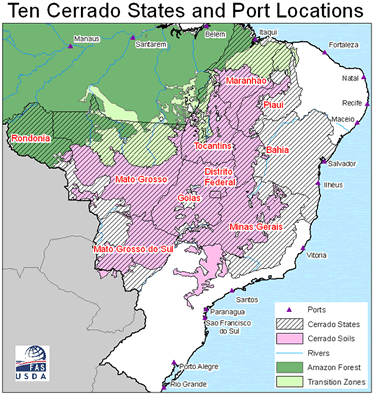
Figure 4. Ten Cerrado States and Major Port Locations
Additional Options for Improving Brazil’s Productivity in the Center-West
Brazil expanded their agricultural production during the past 40-years largely due research advances by Brazilian scientists that allowed the cerrado soils to be developed for crop production and by developing plant varieties that could survive tropical conditions where numerous pest and diseases thrive from high humidity and warm temperatures that never drop below freezing. The tropical climate with high annual rainfall and a long growing season also provides producers with the unique opportunity to double-crop, whereby the second season crop can often be planted on the same day the first season crop is harvested. Other advances in farming systems, such as no-till systems with direct seed applications, also help to reduce soil erosion and improve yields for Brazilian producers on cerrado soils (refer to Figure 5).
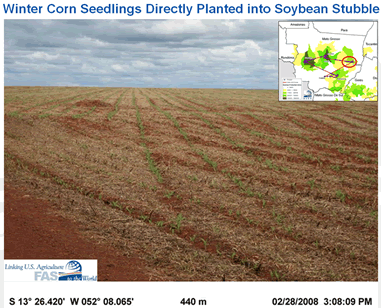
Figure 5. No-till System and Direct Seed Planting
Cerrado soils in Brazil tend to be acidic, saturated with aluminum, low in phosphorous, have low water-holding capacities, and receive high rainfall amounts for those regions bordering the Amazon forest. Brazilian scientists discovered that adding lime to cerrado soils helped to reduce soil acidity and neutralized the free aluminum in the soil, which then easily allowed plants to absorb needed nutrients from fertilizers. Brazilian scientists also learned how to breed soybean varieties that fixed nitrogen in the soil under tropical climates. Soy in Brazil also was found to rotate well with corn and cotton, because soy fixes nitrogen into the soil while both cotton and corn have large appetites for nitrogen. The end result from these research advances is that national soybean yields in Brazil have begun to exceed annual soybean yields in the United States (refer to Figure 6).
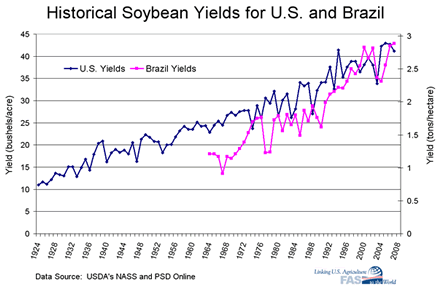
Figure 6. Brazil Soybean Yields Compared to the U.S.
In summary, the Embrapa Cerrados research institute noted that cerrado soils and tropical climates provided the following agricultural challenges in the cerrado states:
- Limited knowledge about natural resources in the tropics such as lack of soybean varieties that fixed nitrogen into soils in the tropics, or lack of crop varieties that can tolerate high aluminum levels.
- Irregular rainfall distribution (dry season and dry spells) on soils with low water storage capacities.
- Acidic soils with low soil fertility and high aluminum and iron concentrations.
- Higher risk of soil erosion due to high rainfall rates and friable soils vulnerable to conventional deep plowing.
- Higher risk of pests, diseases, and weed outbreak due to high rainfall, high humidity, and above freezing temperatures that do not kill worms and pests.
- Inappropriate farming systems such as mono-cropping.
Future options and current trends to improve agricultural productivity in the cerrado states include:
- Continue to develop higher yielding cultivars for the tropics by improving soybean varieties for shorter seasons, aluminum tolerance, rust resistance, and better seed quality
- Develop earlier maturing soy varieties that accelerate first crop harvesting and increase early planting of a second season crop.
- Improve agro-climatic zoning to obtain better variety selection and reduce weather risks in regions with double-cropping potential.
- Avoid planting second season soybeans that could extend into the 90-day Free Host Period (FHP) by increasing double-crop systems whereby the second crop is not soybeans.
- Increase crop rotations to increase yields and help control soybean Asian rust, nematodes, and other tropical worms, pests and diseases.
- Reduce mono-cropping systems because more crop rotations will help to control the many pests and diseases found in the tropics.
- Improve farm diversification by increasing crop rotations and improving integration between crop and livestock systems
- Increase feedlots as more pastures are slowly being converted to cropland
- Increase second-season sorghum and millet for use as animal feed on feedlots.
- Increase drought resistant crops (such as sorghum and millet) for second season crops that have higher drought risks.
- Expand nitrogen fixation to other crops such as grasses, rice, sugarcane, wheat, and even corn.
- Increase in-country fertilizer production.
*Cerrado states in this report are defined as Maranhao (MA), Piaui (PI), Tocantins (TO), Mato Grosso (MT), Rondonia (RO), Goias (GO), Minas Gerais (MG), Distrito Federal (DF), Mato Grosso do Sul (MS), and Bahia (BA) (refer to Figure 4).
Related FAS Links
OGA Photo Gallery for Brazil
Additional OGA Images and Photos about Brazil
Crop Explorer Weather and Vegetation Condition Data for Brazil
FAS Soybean GAIN Report (March 7, 2008)
FAS Annual Grain GAIN Report (March 19, 2008)
Figure 1. 2008 Crop Assessment Route in Parana and Mato Grosso
Figure 2. Summer and Winter Corn Yields in Brazil
Figure 3. Brazil Corn Yields Compared to the U.S.
Figure 4. Ten Cerrado States and Major Port Locations
Figure 5. No-till System and Direct Seed Planting
Figure 6. Brazil Soybean Yields Compared to the U.S.
Current USDA area and production estimates for grains and other agricultural commodities are available on IPA's Agricultural Production page or at PSD Online.
|

